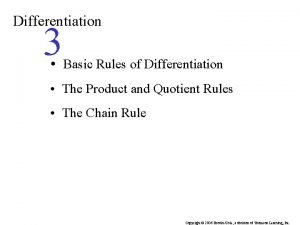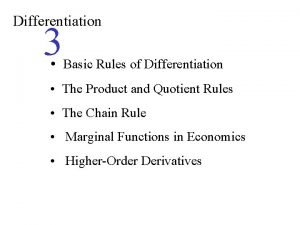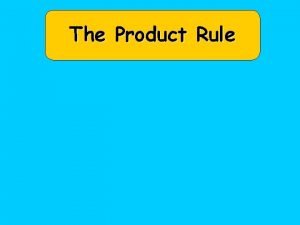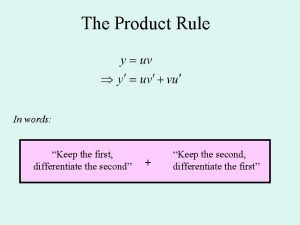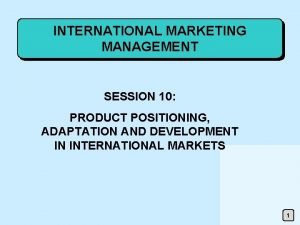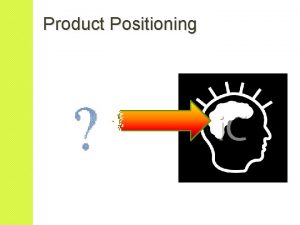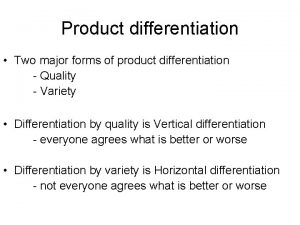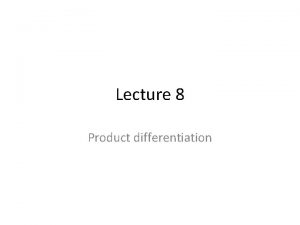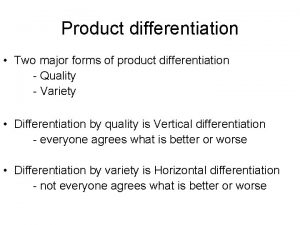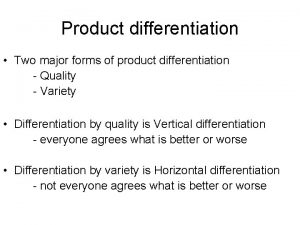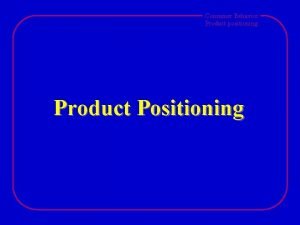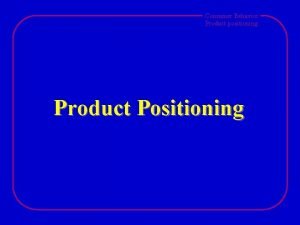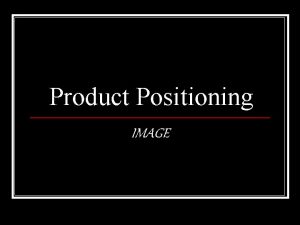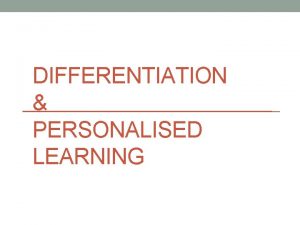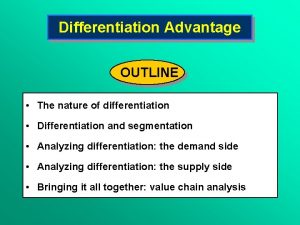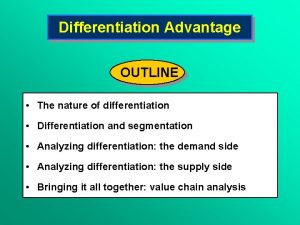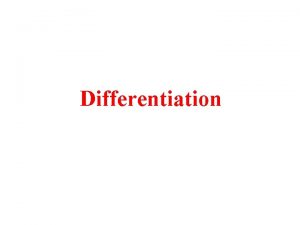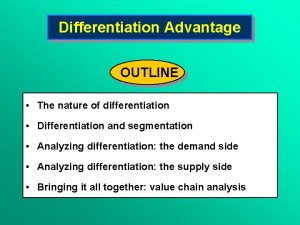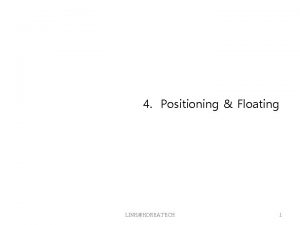Differentiation and Positioning Product Position The way the



























- Slides: 27

Differentiation and Positioning

Product Position • The way the product is defined by consumers on important attributes--the place the product occupied in consumers’ minds relative to competing products. • “Products are created in the factory, but brands are created in the mind. ”

Product Position Samples • Tide: a powerful, all-purpose family detergent • Ivory: the gentle detergent for fine washables and baby clothes. • Subway restaurants: eat fresh

Product Position Samples • Nissan March and Honda Jazz: economy • Mercedes and Cadillac: luxury

Product Position Samples • Porsche and BMW: performance • Volvo: safety

Product Position Samples • Toyota’s fuel-efficient q. Hybrid Prius: high-tech solution to the energy shortage

Product Position • Consumers position products with or without the help of marketers. • Marketers must… ØPlan positions that will give their products the greatest advantage in selected target markets ØDesign marketing mixes (4 Ps) to create these planned positions.

Positioning Maps • Perceptual positioning maps show consumer perceptions of their brands versus competing products on important buying dimensions. • Important buying dimension: – Price – Quality – Service environment/ location – Choice of products/services – Etc.

Positioning Map “U. S. Large Luxury Sport Utility Vehicle Market” *Location of each circle 160 shows where consumers position a brand on two dimensions: price and luxury-performance 120 orientation. Escalade ESV Hummer H 1 Hummer H 2 Infiniti QX 56 Range Rover Lexus LX 470 Navigator Land Cruiser Price (thousands of $) 80 *Size for each circle indicates the brand’s relative market share in the segment. 40 luxury Performance Orientation

Choosing a Differentiation and Positioning Strategy • A brand’s positioning must serve the needs and preferences of well-defined target markets.

Choosing a Differentiation and Positioning Strategy • 3 steps of differentiation and positioning task: 1) Identifying a set of differentiating competitive advantages upon which to build a position 2) Choosing the right competitive advantages 3) Selecting an overall positioning strategy • Then the company must effectively communicate and deliver the chosen position to the market.

1) Identifying Possible Value Differences and Competitive Advantages • Competitive Advantage: an advantage over competitors gained by offering greater customer value, either through lower prices or by providing more benefits that justify higher prices.

1) Identifying Possible Value Differences and Competitive Advantages • To find points of differentiation, marketers must think through the customer’s entire experience with the company’s product or service. • It can differentiate along the line of product, services, channels, people, or image.

Product Differentiation • Brands can be differentiated on features, performance, or style and design. • Bose positions its speakers on the striking design and sound characteristics. • Panasonic positions its Toughbook PCs, designed to stand up to rugged use on the road or in the field, as “durable, reliable, wireless—protect your work no matter where you work. ”

Service Differentiation • Some companies gain service differentiation through speedy, convenient, or careful delivery. • TD Bank has positioned itself as “the most convenient bank in America”—it remains access to the bank 24 hours a day, 7 days a week.

Channel Differentiation • Firms that practice channel differentiation gain competitive advantage through the way they design their channel’s coverage, expertise, and performance. • Amazon. com and GEICO set themselves apart with their smooth functioning direct channels.

People Differentiation • Companies can hire and train better people than their competitors do. People differentiation requires company select its customer-contact people carefully and train them well. • Singapore Airlines has an excellent reputation, largely because of the grace of its flight attendants.

Image Differentiation • A company brand image should convey the product’s distinctive benefits and positioning. • Developing a strong and distinctive image cannot do overnight using a few advertisements.

2) Choosing the Right Competitive Advantages • How Many Differences to Promote? • Many marketers think that companies should aggressively promote only one benefit (unique selling proposition: USP) to the target market. • Buyers tend to remember number one better, esp. in this overcommunicated society.

2) Choosing the Right Competitive Advantages • Which Differences to Promote? • Not every difference make a good differentiator. Each difference has the potential to create company costs as well as customer benefits.

2) Choosing the Right Competitive Advantages • Which Differences to Promote? • A difference is worth establishing to extent that it satisfies the following criteria: q. Important: the difference delivers a highly valued benefit to target buyers q. Distinctive: competitors don’t offer the difference, or company can offer it in a more distinctive way. q. Superior: the difference is superior to other ways that customers might obtain the same benefit.

2) Choosing the Right Competitive Advantages • Which Differences to Promote? • A difference is worth establishing to extent that it satisfies the following criteria: q. Communicable: the difference is communicable and visible to buyers q. Preemptive: competitors can’t easily copy the difference. q. Affordable: Buyers can afford to pay for the difference. q. Profitable: the company can introduce the difference profitably.

3) Selecting an Overall Positioning Strategy • Value proposition: the full positioning of a brand—the full mix of benefits upon which it is positioned. – It is the answer to the customer’s question “why should I buy your brand? ” • Volvo’s value proposition: safety also include reliability, roominess, and styling, all for a price that is higher than average but seems fair for this mix of benefits.

Developing a Positioning Statement Positioning statement: • A statement that summarizes company or brand positioning—it takes this form: • “To (target segment and need) our (brand) is (concept) that (point-of-difference). ”

Developing a Positioning Statement State the product’s membership in a category Positioning statement sample: • “To busy, mobile professionals who need to always be in the loop, Blackberry is a wireless connectivity solution that gives you an easier, more reliable way to stay connected to data, people, and resources while on the go. ” Show its point of difference from other members of the category

Communicating and Delivering the Chosen Position • Positioning the company calls for concrete action, not just talk. If the company decides to build a position on better quality and service, it must deliver that position.

• Segmentation • Targeting • Positioning (including statement)
 Positioning involves meeting consumers lower performance
Positioning involves meeting consumers lower performance Segmentation
Segmentation Glisside
Glisside Differentiation formulas
Differentiation formulas Basic differentiation formulas
Basic differentiation formulas Differentiation division rule
Differentiation division rule Differentiation product rule
Differentiation product rule Product formula of differentiation
Product formula of differentiation What is product differentiation
What is product differentiation Differentiating process examples
Differentiating process examples Cage framework
Cage framework Clean edge razor
Clean edge razor Positioning by cultural symbols examples
Positioning by cultural symbols examples Product positioning in international market
Product positioning in international market One way table and two way table
One way table and two way table Explain threaded binary tree
Explain threaded binary tree Perbedaan one way anova dan two way anova
Perbedaan one way anova dan two way anova The old way and the new way
The old way and the new way Fundamental and derived positions
Fundamental and derived positions Perbedaan one way dan two way anova
Perbedaan one way dan two way anova Hypothesis for two way anova
Hypothesis for two way anova One way anova vs two way anova
One way anova vs two way anova Analisis two way anova
Analisis two way anova This way that way over the irish sea
This way that way over the irish sea Walk this way talk this way
Walk this way talk this way Fundamental position vs anatomical position
Fundamental position vs anatomical position New product development and product life cycle strategies
New product development and product life cycle strategies Marginal product and average product
Marginal product and average product



